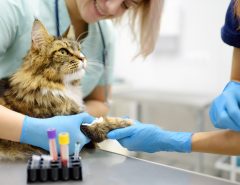Veterinarians play a crucial role in maintaining our pets’ health, and determining the appropriate treatment involves a detailed and systematic approach. They gather comprehensive medical histories, perform thorough physical examinations, and utilize advanced diagnostic tools. By combining these insights with their expertise, vets can tailor treatment plans specific to each pet’s needs, ensuring effective and compassionate care to aid their recovery and overall well-being.
This process thoroughly assesses your pet’s condition and considers various factors to ensure the most effective and suitable treatment plan. Here are the key steps veterinarians follow to determine the appropriate treatment for your pet.
1. Comprehensive Physical Examination
A comprehensive physical examination is the first step in determining the appropriate treatment for your pet. This allows the veterinarian to observe and assess your pet’s overall health, identifying any visible signs of illness or discomfort. During the examination, the vet will check your pet’s vital signs, such as heart rate, respiratory rate, and temperature, and inspect the eyes, ears, mouth, skin, and coat for abnormalities. To understand more about what a thorough physical examination entails, you can see this page, which provides detailed information and guidelines for pet health assessments.
2. Detailed Medical History
A detailed medical history is crucial in understanding your pet’s health background. This includes information about previous illnesses, surgeries, medications, vaccinations, diet, and lifestyle. A thorough medical history helps the veterinarian identify potential risk factors and underlying conditions that may influence the treatment plan. It also provides context for the current health issue and guides the diagnostic process.
3. Diagnostic Tests and Imaging
Based on the initial examination and medical history, the veterinarian may recommend diagnostic tests and imaging to gain deeper insights into your pet’s condition. Common diagnostic tests include blood tests, urinalysis, fecal exams, and skin scrapings. Imaging techniques such as X-rays, ultrasounds, and MRI scans can provide detailed views of internal structures, helping to identify issues that are not apparent during a physical examination.
4. Assessment of Symptoms
Veterinarians carefully assess the symptoms your pet is experiencing to determine the most likely cause of the problem. This involves evaluating the symptoms’ severity, duration, and frequency and any patterns or triggers. Symptom assessment helps narrow the potential diagnoses and guides the selection of appropriate diagnostic tests and treatments.
5. Consideration of Underlying Conditions
In many cases, underlying conditions can complicate diagnosing and treating your pet’s current health issue. Veterinarians consider any chronic conditions, such as diabetes, kidney disease, or arthritis, that may affect the treatment choice. Understanding these conditions is essential for developing a comprehensive treatment plan that addresses all aspects of your pet’s health.
6. Collaboration with Specialists
For complex or severe cases, veterinarians may collaborate with specialists to ensure the best possible care for your pet. Specialists, such as veterinary cardiologists, oncologists, or dermatologists, bring additional expertise and can provide advanced diagnostic and treatment options. Collaboration with specialists ensures a multidisciplinary approach to your pet’s health, improving the chances of successful outcomes.
7. Tailoring Treatment Plans
Once a diagnosis is made, veterinarians tailor the treatment plan to meet your pet’s specific needs. This involves selecting the most appropriate medications, therapies, and interventions based on the diagnosis and your pet’s overall health. The treatment plan may include prescription medications, dietary changes, physical therapy, surgery, or other specialized care. For more info on pet vaccinations and parasite prevention, you can visit this website: https://www.johnscreekvet.com/site/veterinary-services-johns-creek/cat-dog-vaccinations-parasite-prevention. The goal is to create a personalized plan that maximizes effectiveness and minimizes potential side effects.
8. Monitoring and Follow-Up
Monitoring your pet’s progress is a crucial aspect of determining the effectiveness of the treatment. Regular follow-up visits allow the veterinarian to assess how well your pet responds to the treatment and make any necessary adjustments. Monitoring also helps identify any side effects or complications early, ensuring timely intervention and optimal care.
9. Owner Education and Involvement
Veterinarians emphasize educating pet owners about their pet’s condition and treatment plans. Clear communication and detailed instructions help ensure that pet owners can effectively manage their pet’s care at home. Veterinarians encourage active involvement from pet owners, including administering medications, monitoring symptoms, and providing supportive care to enhance the treatment’s success.
10. Consideration of Pet’s Quality of Life
Throughout the diagnostic and treatment process, veterinarians consider the pet’s quality of life. The goal is to treat the illness and ensure your pet remains comfortable and happy. This involves assessing pain levels, mobility, and overall well-being and integrating their pet grooming services to maintain hygiene and improve your pet’s quality of life. Adjusting the treatment plan to cater to these aspects is critical to achieving the best possible outcomes.
Wrapping Up
Veterinarians take a thorough and multifaceted approach to determining the appropriate treatment for your pet. By conducting comprehensive physical examinations, gathering detailed medical histories, utilizing diagnostic tests and imaging, assessing symptoms, considering underlying conditions, collaborating with specialists, tailoring treatment plans, monitoring progress, educating pet owners, and prioritizing the pet’s quality of life, veterinarians ensure that your pet receives the best possible care.




